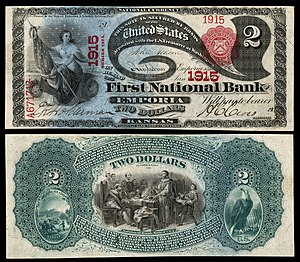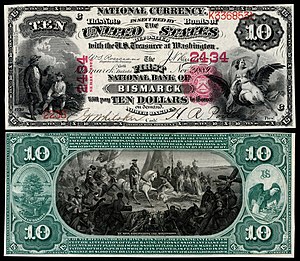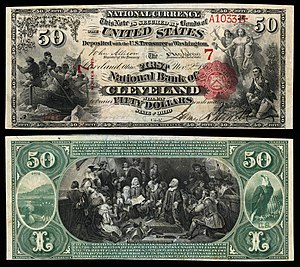How Many Bills On A 1902 Money Sheet

The first $10 National Depository financial institution Note issued by The First National Bank of Hawaii at Honolulu, Territory of Hawaii (1900), signed by Cecil Brown (President) and Westward.G. Cooper (Cashier). The vignette at left shows Benjamin Franklin conducting the famous Kite experiment. The 5550 in brown ink (and large numerals on the contrary) is the issuing banking company'due south national charter number, also shown in the note'south edge engraving.
National Banking concern Notes were United States currency banknotes issued by National banks chartered past the U.s.a. Government. The notes were normally backed by Us bonds the bank deposited with the United States Treasury. In addition, banks were required to maintain a redemption fund[1] amounting to five percentage of any outstanding note balance, in gilded or "lawful money." The notes were not legal tender in general, but were satisfactory for almost all payments to and by the federal government.
National Bank Notes were retired equally a currency blazon by the U.S. government in the 1930s, when U.S. currency was consolidated into Federal Reserve Notes, United states Notes, and silver certificates.
Background [edit]
Prior to the American Ceremonious War, state banks and chartered individual banks issued their own banknotes. Privately issued banknotes were nominally backed by specie (difficult coin) or financial securities held by the banks just oversight of issuing banks often was lax and encouraged mutiny banking, in which fraudulent institutions issued worthless banknotes. During the Civil War, in 1863, the National Banking Act established a system of National Banks which were empowered to issue National Depository financial institution Notes field of study to federal oversight. The chartering of banks and administrative control over the issuance of National Banking concern Notes were the responsibility of the Role of the Comptroller of the Currency.[2] A two per centum tax on country banking company notes was authorized in 1864 to speed conversion to the new system, only to be increased the next twelvemonth to x percentage, then 20 percent.
The program [edit]
From 1863 to 1935, National Banking concern Notes were issued by banks throughout the country and in US territories. Banks with a federal charter would deposit bonds in the U.s. Treasury. The banks then could issue banknotes worth up to 90 percent of the value of the bonds. The federal government would dorsum the value of the notes—the issuance of which created a need for the government bonds needed to back them.
The plan was a form of monetization of the Federal debt. Bonds eligible as collateral for posting to the Treasury were said to have the "apportionment privilege" and the interest they bore provided seigniorage to the National Banks.
The notes [edit]
Each National Bank Annotation diameter the issuing bank'southward national lease number as well equally the serial number assigned to the notation by that depository financial institution. Depression serial-numbered notes were often withdrawn every bit souvenirs by the bank officers who signed them.
Large size notes [edit]
Except for the last few years of issue, all of the National Bank Notes were large-sized.
Through much of their earlier history of outcome, national banknotes used designs in which the issuing depository financial institution's name was prominently displayed, rather than "The Us". One design used for many years featured a portrait on the obverse, virtually the left edge, and the bank's name printed in prominent shaded blazon in the middle. The historical figures seen on these notes commonly were different from those on the same denominations of paper currency today.
Large-size notes bore two serial numbers. The Treasury series number indicated the total number of notes of that series and denomination issued by all banks. The bank serial number indicated the number of notes of that serial and denomination issued only past that bank. Large size notes also bore four signatures. Two signatures were those of the Annals of the Treasury and Treasurer of the Usa and were printed every bit part of the note's design. The other two signatures were those of the depository financial institution'southward cashier and president, and were individually signed past those officers prior to issuing the note. Notes were sent to the bank by the Treasury and typically signed as uncut sheets, so that the pinnacle edge of some notes prove the lower part of a signature (such every bit the descender of a "y" or "j") from the annotation above it. Notes were often cut apart with scissors, then that the top and bottom edges of notes can be uneven and cutting into the borders of the blueprint.
Most, just not all, large size national banknotes showed the lease number of the issuing bank on the obverse. In some cases the charter number was printed once, but typically the charter number appeared twice. The issuing bank'due south lease number was carefully positioned inside the engraved edge, as well equally overprinted elsewhere on the obverse. To aid Treasury workers in sorting banknotes, subsequently large size notes also showed a letter to indicate the region of the country in which the issuing bank was located—"N" for New England, "E" for East, "Southward" for Southward, "Chiliad" for Mid-West, "W" for West, and "P" for Pacific coast.
The start issue of National Banking concern Notes [edit]
| Value/serial | Bank championship | Banknote |
|---|---|---|
| $1 Original Series | The First National Bank Lebanon, Indiana |  |
| $2 Series 1875 | The First National Depository financial institution Emporia, Kansas |  |
| $5 Series 1875 | The Vineland National Banking concern Vineland, New Bailiwick of jersey |  |
| $10 Serial 1875 | The Beginning National Bank Bismarck, North Dakota |  |
| $xx Series 1875 | The Offset National Banking concern Butte, Montana |  |
| $50 Serial 1875 | The Beginning National Banking company Cleveland, Ohio |  |
| $100 Original Series | The Raleigh National Bank Raleigh, North Carolina |  |
| $500 Original Series[nb 1] | The Appleton National Bank Lowell, Massachusetts |  |
| $1,000 Serial 1875 (proof)[nb 2] | The Outset National Banking company Salem, Massachusetts |  |
Pocket-sized size notes [edit]

A small-size National Bank Note, series of 1929
With the advent of small-size banknotes came significant design changes for all types of newspaper currency including National Bank Notes. As a consequence of the changes, each denomination now had the aforementioned portrait and, except for minor variations, the same decorative features that would narrate all types of The states currency from the late 1920s to the early 1990s. In the example of National Banking company Notes, the elaborate rendition of the banking concern'southward proper noun was omitted from the engraved pattern with the change to small-size notes, and instead was now simply over-stamped in black ink, just to a higher place the engraved lettering of the promise-to-pay. Similarly, the issuing bank's charter number was omitted from the engraved border, and at present simply overprinted in dark ink. In the example of the final issues of small size National Depository financial institution Notes, referred to as Blazon 2 notes, the lease number also appeared twice in brown ink in line with the notation'south serial numbers.
Small-scale size National Bank Notes look very like to, but are distinctly different from, the emergency 1933 issue of the Federal Reserve Bank Notes. These were printed using National Depository financial institution Annotation plates with slight design changes. Both say "National Currency", only accept different issuers.[iii]
End of the plan [edit]
National Bank Notes were retired as a currency type by the U.S. government in the 1930s during the great low every bit currency in the U.S. was consolidated into Federal Reserve Notes, The states Notes, and silvery certificates; privately issued banknotes were eliminated. The passage of the Gold Reserve Human activity created an accounting gain for the Treasury, part of which was used to provide funds to retire all bonds against which National Banks Notes could exist issued.
Sometimes these notes are chosen "hometown" notes, with their popularity deriving from the wide range of towns and cities that issued them. Among paper coin hobbyists, peculiarly in the U.South., these notes are avidly studied and collected. Some were issued in big numbers and remain cheap to collectors today. Others associated with rare banks, towns, states and combinations thereof and are quite valuable. A notation from Walla Walla, in what was then Washington Territory, sold for $161,000 in a June 2010 sale at Heritage Auctions.[iv]
Encounter too [edit]
- Higgins Museum of National Bank Notes
Footnotes [edit]
- ^ Three notes are reported: two in government collections and ane in a private collection.
- ^ No issued notes have been reported to exist.
Notes [edit]
- ^ "National Banking company Notation". Webster's new international dictionary of the English linguistic communication. Second edition. 1949: G&C Merriam Company, Springfield, MA. p 1629
- ^ "Bureau of Engraving and Press". www.moneyfactory.gov. Archived from the original on 2002-11-ten.
- ^ National Depository financial institution Notes - Values and Pricing Data
- ^ Walla Walla, Washington Territory - $five 1875 Fr. 403 The Starting time NB Ch. # 2380
References [edit]
- Six Kinds of United states Paper Currency
- National Bank Notes, 1864-1935: Production, Issuance, Redemption, and Circulation
- Bank Note History Projection
Source: https://en.wikipedia.org/wiki/National_Bank_Note
Posted by: vegafallsocring.blogspot.com

0 Response to "How Many Bills On A 1902 Money Sheet"
Post a Comment